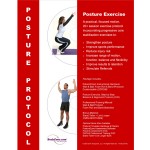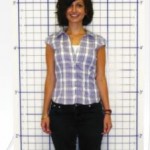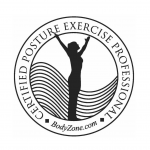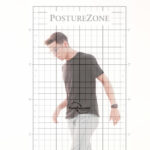Using Posture Grids for Assessment
 PostureZone® posture assessment grids are tools for both documentation and communications. The numbered horizontal and symmetric vertical lines (and corresponding measurements) are a photogrammetric framework to clinically measure and benchmark structure.
PostureZone® posture assessment grids are tools for both documentation and communications. The numbered horizontal and symmetric vertical lines (and corresponding measurements) are a photogrammetric framework to clinically measure and benchmark structure.
Multiple studies on postural photogrammetry report significant correlation across multiple postural variables.
Read on for tips and video instruction.
FRONT & BACK VIEW POSTURE PICTURES
For front and back view images, the vertical and horizontal lines make it easy to pinpoint lack of symmetry.
Focusing from the bottom up, the clinician can observe and note numerically from the grid if:
- The lateral edge of one foot is different from the other
- The lateral edge of the pelvis is different on the left vs the right
- One shoulder is higher than the other
- A greater number of boxes visible between the arm and the body when one upper extremity is held closer to the body than the other
- A leftward deviation of the head compared to the line traveling up from between the feet
SIDE VIEW POSTURE PICTURES
When using a grid alone we suggest focusing on the top of the kinetic chain – where’s the head compared to the torso, and where is the head compared to the feet (the point over which the whole body is balancing)?
Additional information can be combined with PostureZone® app measurements, or added from less easily quantified observations such as rounding of the torso (although such long term changes can be especially impactful when comparing pictures taken pre and post care and/or postural rehab programs).
When using the grid alone: On side/lateral views, focus on the alignment of back (posterior) margins of the feet, buttocks, shoulder blades, and head. On front/back (AP/PA) views, focus on symmetry between left and right. Each PostureZone® approximates the center of masses which are being balanced in just about any vertical posture.
PATIENT COMMUNICATIONS
Remember, as a practitioner you observe a greater amount of detail than your patient or client. Deliver powerful A-HA moments by pointing out big chunk concepts instead of the finite detail. The measurements on the grid provide easily understandable talking points.
For example:
- Follow the center line that begins between your feet. Does it end center of the top of your head? No?
- Notice that the finger tips on your right hand hang 2 inches lower than the finger tips on your left hand.
- Your hips aren’t level, in fact we can see that your right hip is at about 3′ 2″, and your left 3′ 5″. 3 inches doesn’t sound like a lot but let me tell you why that makes a difference in how your body moves and wears over time.
- See how this line rests on your right shoulder, but hovers above your left shoulder? You’re shoulder height is 4′ 6″ on the right and 4′ 8″ on the left.
While you’ll certainly see a lot more detail, these simple concepts resonate with people when viewing their own assessments. Combined with the visual evidence of the picture and measurements, your explanation will build understanding, trust and ultimately compliance.
People are excited to come back because they want to see their numbers change (evidence of improvement) on follow up posture pictures.
When using the grid in research the grid backdrop allows you to capture and relay additional numeric detail beyond the report and analysis findings.
WHERE CAN I PURCHASE A POSTURE GRID FOR THIS PHOTOGRAMMETRIC METHOD?
PostureZone grids are available from the manufacturer, PostureZone.com, as well as BodyZone.com. Other resellers like Chiro1Source and ClinicalCharts may also carry them. We recommend “PostureZone” Wall and Door mount as the most durable grids in the industry.
Additional Reading:
- 5 Ways Posture Pictures are Better than Xrays >>>
- Postural Link from Neck Muscles to the Neurology of Breathing and Swallowing
- Specializing in Posture Correction >>>
For more about StrongPosture® take the latest training via online course or hands-on seminar.

























